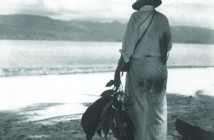MEET DAVID FAIRCHILD AND TAKE A WALK WITH SOMI MAGAZINE.
OBSERVING SEVENTY-FIVE YEARS OF FAIRCHILD TROPICAL BOTANIC GARDEN
Dedication ceremony, March 23, 1938Fairchild Tropical Botanic Garden is commemorating an important year in its role as a horticultural and cultural diamond in South Florida. Beginning with their kick-off event in March 2013, the year-long party, which will end in March 2014, features an event-filled calendar to celebrate the garden’s 75th anniversary. Offerings include historic trams and walking tours, lectures and musical performances along with the Fairchild’s regular programs and events. Favorite festivals such as the Chocolate, Mango, Orchid, Food and Garden, and Edible Garden remain on the schedule, as well as the Ramble, art exhibits, plant shows and afternoon teas. “We are marking an important historic milestone, recognizing the incredible growth now underway and pushing our mission forward into the future in innovative ways. There has never been a more exciting time at Fairchild,” said Dr. Carl Lewis, Director of Fairchild.
The Montgomery’s walking with David Fairchild at the dedication. David Fairchild planting the Baobab tree.THE GARDEN IS PLANTED
This popular 83-acre paradise within the larger paradise of South Florida was founded by Colonel Robert Montgomery and named in honor of Dr. David Fairchild on March 23, 1938. Fairchild served as the Head of the Office of Foreign Seed and Plant Introduction of the United States Department of Agriculture from 1897 to 1928. Referred to in government publications as “Agricultural Explorer,” Fairchild was just that and one of the most influential horticulturalists and plant collectors in the country. Traveling extensively, he collected and introduced more than 30,000 varieties and species of plants to the U.S. Many of the original plants he brought to the garden continue to grow to this day. Currently, Fairchild supports some 22,800 catalogued plants that comprise more than 3,400 species—a phenomenal increase from the 1939 inventory of 692 plants and 243 species. Fairchild’s palm and cycad collection are among the greatest in the world.
Fairchild Tropical Botanic Garden has always kept sight of the founders’ original intent of exploring, explaining and conserving the world of tropical plants. Once, this place of refuge was something of a passive experience, but today it has evolved into a venue that includes many opportunities for interactive experiences. In addition to being an essential community resource, it is a premier conservation, educational and cultural center that annually hosts 400,000 visitors and over 100,000 school children. Membership has grown over the years, from 285 in 1939, to 1,000 in 1993, to an impressive 45,000 today.
Dr. Lewis, remarking on the Fairchild’s progress since the 1938 dedication said, “During the 75 years that followed, the transformation of our landscapes and programs has been astounding. We are now a stronger, livelier and more renowned institution than any of our founders anticipated.”
Arboretum – Now Arboretum – Then PAUL AND SWANEE DIMARE
SCIENCE VILLAGE
One example that underscores Dr. Lewis’ observation is the Paul and Swanee DiMare Science Village. Opened in December 2012, the new complex is dedicated to the expansion of the Fairchild’s scientific mission. More than 25,000 square feet of land are devoted to the village, laboratories, classrooms and an impressive 40-foot high butterfly and hummingbird conservatory. Students enrolled at the University of Miami, Florida International University and the University of Florida will attend classes here to study genetic research, climate modeling, plant propagation and animal life, among other related disciplines. The goal for Fairchild is to become a hub for undergraduate and graduate studies.
Visitors, too, have the opportunity to appreciate and learn from the conservatory thanks to the garden’s highly trained volunteer corps. The lushly landscaped conservatory complete with a stream, tropical plants and rare orchids is home to a profusion of exotic butterflies gliding serenely from plant to plant; the adjacent laboratory provides insight into the lifecycle of the butterfly as it metamorphoses from pupa to adult.
EDUCATING FUTURE GENERATIONS
Education remains at the center of the Fairchild’s mission. The Fairchild Challenge is an education program for students from elementary through high school from 250 schools in Miami-Dade and Broward counties. The Challenge, an annual, standards-based environmental outreach program, offers a menu of multidisciplinary challenges for over 100,000 students of diverse backgrounds. The goal is to foster an interest in the environment by providing the students the opportunity to appreciate the beauty and value of nature; develop critical-thinking skills; understand the need for biodiversity and conservation; tap community resources; become actively engaged citizens; and recognize that individuals make the difference. The Challenge promotes science, literacy, and creative expression while developing lifelong learning in students. A competitive program, the 16 top-scoring elementary, middle and high schools are awarded $250 to $1,000 for their environmental programs.
A FORCE OF NATURE
The life of the Fairchild, much like our own lives, has been shaped not only by good intentions, but by forces over which there is little to no control. Hurricane Andrew, the literal and figurative watershed by which many South Floridians measure their personal history, also had a profound impact on the garden. Roaring in with winds at 145 mph, gusting to 175 mph (with some micro-blasts estimated at 212 mph), this late August 1992 monster focused its destruction along a 30-mile wide swath through Cutler Ridge, Homestead and Florida City. The Fairchild Garden was well within the storm’s path. In a recent Miami Herald article, Dr. Lewis speaks about the hurricane’s impact on the Fairchild and the community’s reaction to it.
“There have been a lot of milestones, but the one that stands out as a turning point was Hurricane Andrew. That was a point where the garden got a lot of support from the community here in South Florida and elsewhere. The scientific community made it clear how many friends of the garden there were out there. If we look at the diversity of plants in the collection, there has been a steady increase. This dipped after the hurricane and picked up again. If you look at the progress of the garden and contrast that with photos of the devastation, it’s amazing the resilience in the way the garden recovered. We had hundreds of volunteers that literally propped the trees back up,” said Dr. Lewis.
A young student observing at the Butterfly Metamorphosis Lab.The Science Village opened in December 2012 and includes new laboratories, The Clinton Family Conservatory with the Wings of the Tropics butterfly exhibit, and the Tropical Plant Conservatory and Tropical Fruit Pavilion.
BALANCING ART AND NATURE
“Art at Fairchild,” began in 2005 with an exhibit of Dale Chihuly’s ethereal blown glass pieces placed around the garden as man-made complements to the hand of nature. Several of Chihuly’s works remain in the garden as “legacy” art. Other art projects followed, including “Sitting Naturally,” a collection of cleverly-designed benches that function as both seating and works of art. From this initial foray of combining art with Mother Nature, a larger-scale cultural project was born. The new Rose-McQuillan Arts Building, scheduled to open December 2013, was made possible by a major gift of $4 million from Adam R. Rose and Peter R. McQuillan. The 3,000 square foot multi-purpose building now under construction will provide a venue for art exhibitions and musical performances.
Mr. Rose, who is on the board of the New York Botanical Garden said, “The thing that really grabbed us was the notion that you might come to Fairchild because it’s sort of a park, but you might stay because of something else — that you might come for a gardening class and discover chamber music or an art show.’’
Named after its donor, the Jean Ellen duPont Shehan VISITOR CENTER was opened in 2002. Ms. Shehan, a philanthropist and supporter of national and local charities, served on FTBG Board of Trustees before her death in 2011. Dale Chihuly sculpture, End of the Day Tower which is among several pieces which are still on exhibit.IT TAKES A VILLAGE
Anyone with a garden, no matter how small, knows the amount of labor involved in maintaining it. Just imagine caring for gardens spread out on 83 acres. The staff and volunteers at Fairchild operate, tend, educate, conserve, fund-raise, publicize and entertain so that the hundreds of thousands of visitors, students, scientists and event-goers realize a quality experience while on site. The Fairchild also conducts field programs in 20 countries throughout the tropical world.
Of the volunteer corps, Dr. Lewis said, “Our success and growth would not be possible without a great deal of help from our community. Our volunteers are part of everything we do at Fairchild, from behind-the-scenes horticulture and conservation work to visitor services and K-12 education.”
Now under construction, the Adam R. Rose and Peter R. McQuillan Arts Center is scheduled to open in late 2013.



